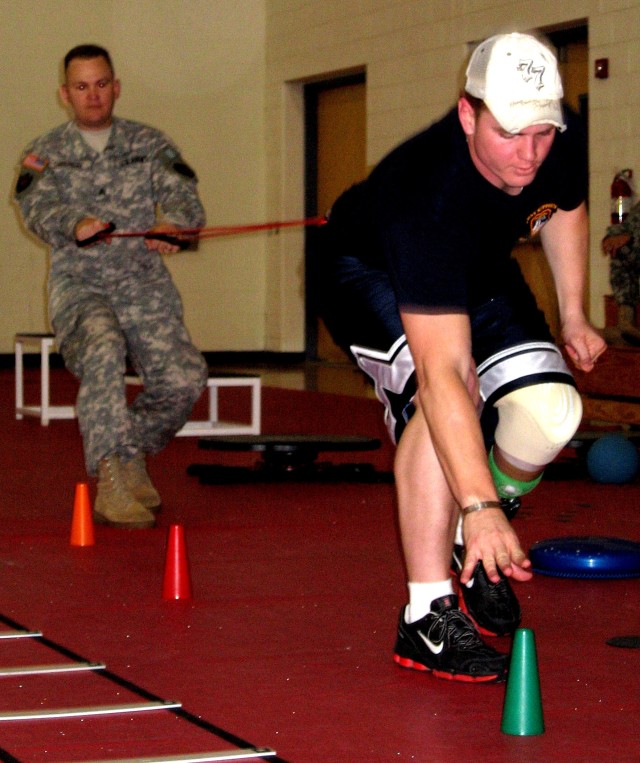WASHINGTON (Army News Service, June 4, 2007) - As the use of improvised explosive devices has continued steadily against U.S. troops in Iraq, the Defense Department has made treating those troops seriously injured in the blasts a top priority.
That was the focus of a three-day workshop for Defense Department and Veterans Affairs medical professionals at Walter Reed Army Medical Center here, who gathered to discuss advancements in treating traumatic amputee patients.
"We in the Army have lived by a Warrior Ethos, and part of that ethos is that we do not leave a fallen comrade. You're seeing that here, exemplified in the work of these great caregivers at Walter Reed Army Medical Center and throughout the Army medical department and the military health system every day," Maj. Gen. Eric B. Schoomaker, commander of Walter Reed, said at the beginning of a media demonstration June 1.
Several of the workshop presenters and Walter Reed patients demonstrated the latest prosthetic technology and the rehabilitation process for amputees.
The Warrior Ethos also includes a commitment to never accept defeat or give up, Maj. Gen. Schoomaker noted, and that's what amputee care and rehabilitation is all about.
"What you're seeing here today is a personification of not accepting defeat and not quitting," he said. "The mission of the warrior who's wounded is to turn that mission focus to restoring their own health and well-being, and restoring their full function. That's what the Army and the joint force is about; it's about restoring the full function and retaining great warriors."
The technologies demonstrated included a "power knee," which is the first motor-powered prosthetic; a powered ankle-foot unit with microprocessor technology to detect changes in terrain; a microprocessor knee with artificial intelligence that recognizes and adjusts to changes in speed; and "cheetah feet," which are prostheses specially designed for sprinting and high-level competition.
Amputee patients also demonstrated different training techniques physical therapists use during rehabilitation. The troops start with running drills that use five steps to introduce the amputee to running with a prosthesis. They move into multi-directional drills, which teach them to move on different planes and work on speed, agility and power. The amputees also work on speed drills, which use resistance to increase stride length and frequency.
Gunnery Sgt. Angel Barcenas was one of the amputees demonstrating training techniques. Gunnery Sgt. Barcenas was wounded by an improvised explosive device in Iraq in July 2006 and lost both legs below the knee. He has been using the "cheetah feet" for about three weeks and on June 1 demonstrated several running drills, one using a parachute for resistance, and agility drills with hurdles.
Gunnery Sgt. Barcenas' healing process went quickly after being transported back to the U.S.; he started walking in September 2006, just three months after being injured. He credits the professionals at Walter Reed for his quick recovery.
"I don't know how they do it," he said. "They have a lot of work to do and they dedicated a lot of time just to me to make sure I was okay."
Gunnery Sgt. Barcenas said that the "cheetah feet" make a huge difference in his running ability, giving him more ability to push off with his ankles and toes. He participated in the entire workshop, which he said showcases a different side of Walter Reed than is usually portrayed.
"They have a tremendous amount of people here with the biggest hearts. They become really good friends; they become really personal, and it helps the patients," he said.
Another important message from this program and others like it is that even traumatic injuries can be overcome, Gunnery Sgt. Barcenas said. "It's possible to get back up on your feet and do exactly the things you were doing before without struggling," he said.
Amputee rehabilitation programs have returned 20 percent of amputees to active service, Maj. Gen. Schoomaker said. "We have Soldiers fighting today in Afghanistan and elsewhere who are wearing prostheses that were fitted and that they were trained to use here," he said.
The Defense Department is committed to investing in cutting-edge technology and partnering with other government agencies and the civilian medical community to provide the best care possible for amputees, Maj. Gen. Schoomaker said. Ultimately, the Defense Department medical community hopes to move beyond injured servicemembers and benefit the U.S. population at large and even the global community, he said.
(Sgt. Sara Wood writes for the American Forces Press Service.)






Social Sharing